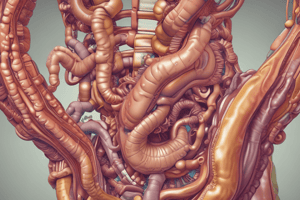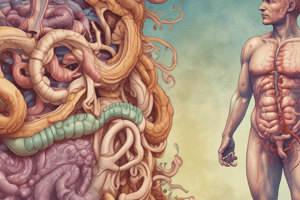Podcast
Questions and Answers
What is the primary goal of treatment in pericolic abscess?
What is the primary goal of treatment in pericolic abscess?
- To drain the abscess and resolve acute inflammation (correct)
- To prevent fistula formation
- To resect the affected segment
- To manage intestinal obstruction
What is the most common cause of massive lower gastrointestinal hemorrhage?
What is the most common cause of massive lower gastrointestinal hemorrhage?
- Vascular malformations
- Colonic cancer
- Inflammatory bowel disease
- Diverticular disease (correct)
Which investigation has the highest diagnostic yield for detecting vesico-colic fistula?
Which investigation has the highest diagnostic yield for detecting vesico-colic fistula?
- Barium enema
- Colonoscopy
- Cystography
- Cystoscopy (correct)
What is the indication for a two-stage procedure in the management of fistula?
What is the indication for a two-stage procedure in the management of fistula?
What is the purpose of endoluminal wall stents in the management of intestinal obstruction?
What is the purpose of endoluminal wall stents in the management of intestinal obstruction?
What is the diameter of the abscess that requires US guided percutaneous drainage?
What is the diameter of the abscess that requires US guided percutaneous drainage?
What is the symptom of chronic intestinal obstruction?
What is the symptom of chronic intestinal obstruction?
What is the investigation of choice to diagnose colovesical fistula?
What is the investigation of choice to diagnose colovesical fistula?
What is the most common complication of chronic diverticulitis?
What is the most common complication of chronic diverticulitis?
What is the typical demographic for uncomplicated diverticulosis coli?
What is the typical demographic for uncomplicated diverticulosis coli?
What is the characteristic symptom of irritable colon syndrome in diverticulosis coli?
What is the characteristic symptom of irritable colon syndrome in diverticulosis coli?
What is the best diagnostic imaging modality for diverticulosis coli?
What is the best diagnostic imaging modality for diverticulosis coli?
What is the pathophysiological mechanism underlying chronic diverticulitis?
What is the pathophysiological mechanism underlying chronic diverticulitis?
What is the commonest location for hemorrhage in diverticulosis coli?
What is the commonest location for hemorrhage in diverticulosis coli?
What is the characteristic radiological feature of 'pre-diverticular state' on barium enema?
What is the characteristic radiological feature of 'pre-diverticular state' on barium enema?
What is the purpose of sigmoidoscopy in the management of diverticulosis coli?
What is the purpose of sigmoidoscopy in the management of diverticulosis coli?
What is the typical location of tenderness in a patient with diverticulitis?
What is the typical location of tenderness in a patient with diverticulitis?
What is the primary goal of the Reilly sigmoid myotomy procedure?
What is the primary goal of the Reilly sigmoid myotomy procedure?
What is the recommended dietary modification for patients with diverticulosis?
What is the recommended dietary modification for patients with diverticulosis?
What is the primary concern when performing a barium enema or sigmoidoscopy in a patient with acute diverticulitis?
What is the primary concern when performing a barium enema or sigmoidoscopy in a patient with acute diverticulitis?
What is the typical clinical presentation of perforation in diverticulitis?
What is the typical clinical presentation of perforation in diverticulitis?
What is the primary indication for surgical intervention in diverticulitis?
What is the primary indication for surgical intervention in diverticulitis?
What is the ideal surgical procedure for treating diverticulitis?
What is the ideal surgical procedure for treating diverticulitis?
What is the diagnostic imaging modality of choice for evaluating perforation in diverticulitis?
What is the diagnostic imaging modality of choice for evaluating perforation in diverticulitis?
Flashcards are hidden until you start studying
Study Notes
Chronic Diverticulitis
- Result of recurrent attacks of acute diverticulitis, with a thickened and adherent colon wall.
- Complications include acute inflammation, perforation, chronic intestinal obstruction, fistula, and hemorrhage.
Complications
- Acute inflammation: most common complication.
- Perforation: leads to peritonitis, either localized (abscess) or generalized.
- Chronic intestinal obstruction: due to fibrosis and strictures.
- Fistula: external (colocutaneous) or internal (colovesical, colovaginal, or coloenteric).
- Hemorrhage: due to erosion of vasa recta, more common in the right colon.
Management
- Uncomplicated: females > males, >40 years old.
- Clinical picture: asymptomatic or irritable colon syndrome with 5 A's (abdominal distension, pain, abnormal stool frequency, form, and passage).
- Signs: thickened, tender, palpable colon.
- Investigations: barium enema, sigmoidoscopy, and CT scanning.
Treatment
- Uncomplicated: high-residue diet, antispasmodic drugs, and bulking agents.
- Complicated:
- Diverticulitis: Ochsner-Sherren regimen, antibiotics, and fluids.
- Perforation: surgical intervention, with Hinchey classification guiding treatment.
- Intestinal obstruction: conservative approach with endoluminal wall stents or surgical intervention.
- Fistula: one-stage or two-stage procedure with resection anastomosis and fistulectomy.
- Bleeding: diagnosis is challenging, and treatment involves identifying and treating underlying causes.
Studying That Suits You
Use AI to generate personalized quizzes and flashcards to suit your learning preferences.




